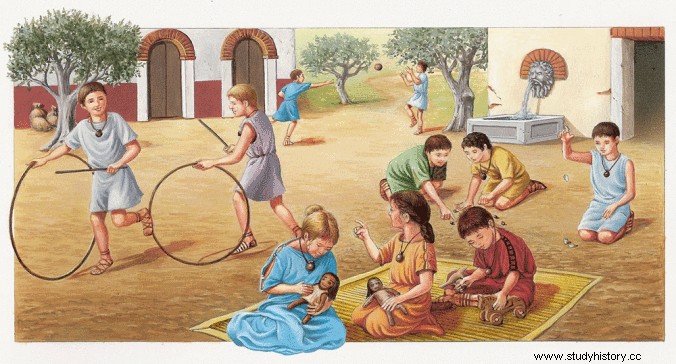Can you imagine modern society without Netflix, Spotify, YouTube, mobile phones, video games or social networks? If you can do it, you will wonder how to satisfy leisure. In Ancient Rome, entertainment had to do with wooden games, such as checkers, chess, backgammon, tic-tac-toe, marbles... Do you know them? In this article we pay homage to some of the games with the most history.
What was the game like without the electronics?

As Francisco Javier Tostado's blog tells us, the games in Roman times were not really so different from those we know today. In fact, it is said that the classic casino roulette was first seen among the Roman legionnaires who used chariot wheels marked with numbers. Gambling was also frequent in Rome - it is said that the emperor Augustus lost 20,000 sesterces in a single night - and, of course, bets and games of chance are the necessary ingredients for the cultivation of gambling. In addition, as some debts were settled even by losing the debtor's freedom, the aleariae laws were enacted. (Lex Cornelia , Lex Publicia and Lex Titia ) that prohibited betting on games of chance. These rules declared legal betting on games or competitions where the result depended on the skill, strength or value of the participants (races in the circus or fights in the amphitheater, for example) and declared illegal those that depended solely on chance, although many of the bettors in the dice commended themselves to the gods. But roulette is not the only historical game, as reported by Betway Casino, there is a theory that blackjack was seen among the Romans who enjoyed the game with a kind of wooden blocks with numerical values. The swing, heads or tails or hide-and-seek were part of his day-to-day life. Others disappeared or simply evolved. Those are some of them…
The Knucklebones
The knucklebones or talus they were bones of sheep, goat or lamb legs that were used in groups of three to four, in a very similar way to the game of dice, using cups to avoid cheating. They had to be six-sided, of which only those that were the same counted. Although animal bones were used, families who could afford it bought pieces of ivory or glass. During the game the best roll was considered the venus and the worst face was the canis . This game was very popular in rural areas and the Spanish, centuries later, introduced it to the American continent.
The marbles
This game (then called ocellates ), made with round stones of baked clay, was the most popular. Apart from those prepared with clay, versions of marbles made with transparent glass whose origin comes from silica and ashes have also been found.
ephedrism
This game consisted of hitting an object on the ground in such a way that the one who lost was forced to carry the one who won on their shoulders, and carry it blindfolded to the goal.
The bronze fly
A child is blindfolded and shouts:“I will catch the bronze fly”. The others reply:“You will chase it but you will not catch it”, and the rest run, imitating the buzzing of flies, avoiding being caught. It would be a version of "blind man's hen".
Micare (morra)
The morra was a sleight of hand game that consisted, and consists, in matching the number of fingers drawn between two players. In Rome, the morra was called micatio , from the verb micare (micare digites , "extend your finger in the game")
Games made with pebbles
Although games were usually made from wood, pebbles were also used for leisure in games such as latrunculi (similar to chess or checkers) or the ludus duodecim litterarum (board where a game similar to three in a row was played).
Finally, it is worth highlighting situations that we continue to imitate today but with technology. For example, newborns were entertained with animal-shaped bells, while today we find bells with lights and music. There were also doll games and kitchens made of carved wood. So we haven't really changed that much, we've just adapted. And you, how do you think traditional games will continue to evolve in the future?
